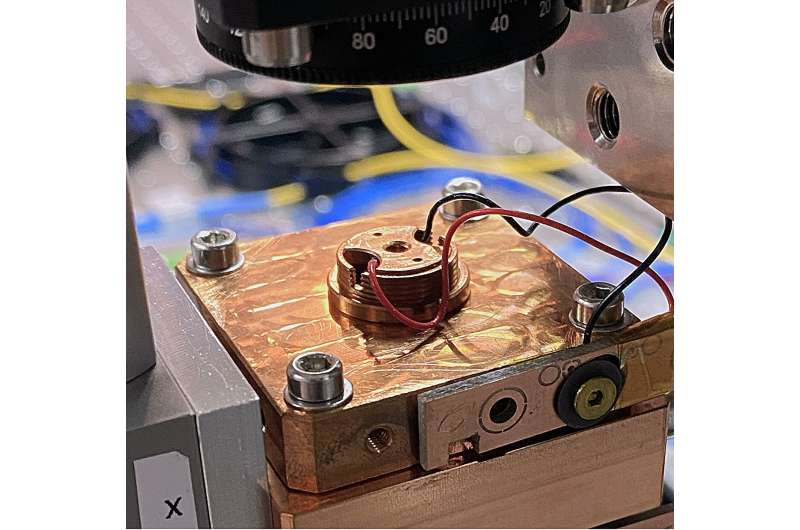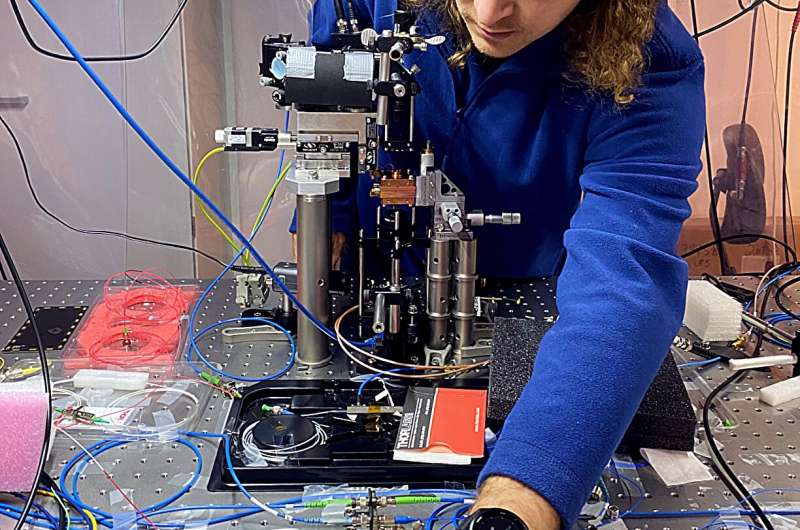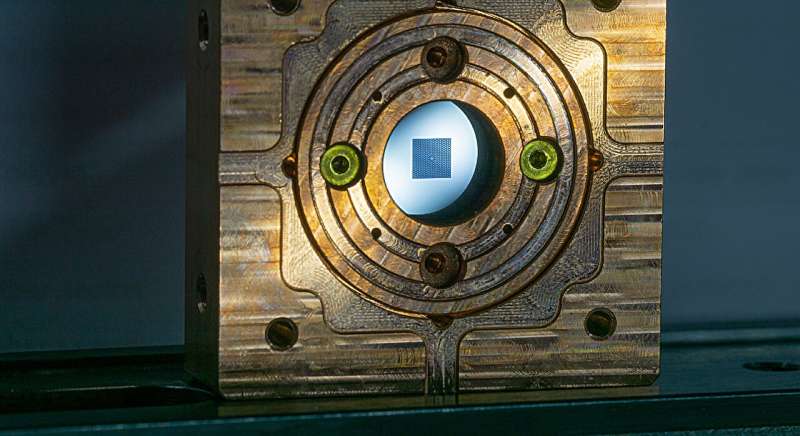The researchers were able to convert light information into vibrations of the membrane inside the quantum drum and back.Photo credit: Julian Robinson-Tate
Researchers at the Niels Bohr Institute at the University of Copenhagen have developed a new method of creating quantum memory: a snare drum can store data sent by light vibrating with sound waves, then forward the data with a new light source when it is needed again. The results suggest that mechanical memory for quantum materials could be a strategy that could pave the way for an incredibly fast, ultra-secure internet.
The research is published in the journal Physical Review Letters.
Directly below Niels Bohr’s old office is a basement with scattered desks covered in small mirrors, lasers and various types of equipment connected by a web of wires and stacks of tape. It looks like the kids’ plans have gone too far and their parents are trying in vain to get them to clean it up.
While it’s hard to see to the untrained eye that these desks are actually home to a range of world-leading research projects, important things happen in a world so small that even Newton’s laws don’t apply. This is where Niels Bohr’s successors in quantum physics are developing cutting-edge quantum technologies.
One project stands out (at least to physicists) because a gadget visible to the naked eye is capable of realizing quantum states. The quantum drum is a small film made of ceramic or glass-like materials with neat holes scattered around its edge.
When a drum is struck with a laser, it begins to vibrate, so quickly and undisturbed that quantum mechanics kicks in. This property has already caused a stir because it opens up the possibilities of many quantum technologies.
Now, the institute’s collaboration across the quantum realm is proving that drums could also play a key role in future quantum computer networks. Like modern alchemists, researchers have created a new form of “quantum memory” by converting light signals into sound vibrations.
In their just-published research article, the researchers demonstrate that quantum data from a quantum computer in the form of an optical signal (for example, through the type of fiber optic cable already used for high-speed Internet connections) can be stored in the quantum computer as vibrations middle. Transfer after drum.

Image source: University of Copenhagen
Previous experiments have shown researchers that membranes can maintain fragile quantum states. On this basis, they argue that the drum should be able to receive and transmit quantum data without becoming “decoherent,” losing its quantum state when the quantum computer is ready.
“This opens up huge prospects for the day when quantum computers can actually do what we expect. Quantum memory may be the basis for sending quantum messages over long distances. The technology we have developed is therefore a key part of the basis,” Niels · said Mads Bjerregaard Kristensen, a postdoc at the Bohr Institute and lead author of the new research article.
Super fast and super safe
When transmitting information between two quantum computers over long distances, or between many quantum computers in a quantum internet, the signal is quickly drowned out by noise. The longer the fiber optic cable, the amount of noise in the fiber optic cable increases exponentially. Eventually, the data can no longer be decoded.
The traditional Internet and other major computer networks solve this noise problem by amplifying signals from small stations along the transmission path. But for a quantum computer to apply a similar approach, the data must first be converted into an ordinary binary bit system, such as that used by ordinary computers.
This won’t work. Doing so would slow down the network and make it vulnerable to cyberattacks, as the likelihood that classical data protection will be effective in future quantum computers is very low.
“Instead, we hope that the quantum drum can take on this task. It has already shown great promise, as it is very suitable for receiving and re-sending signals from quantum computers. Therefore, we aim to extend the connection between quantum computers through the quantum drum Stations that receive and relay signals, doing so to avoid noise while keeping the data in a quantum state.
“In doing so, the speed and advantages of quantum computers, such as those associated with certain complex calculations, will extend to networks and the Internet, as they will be achieved by exploiting properties such as superposition and entanglement that are unique to quantum states.”

Mads Bjerregaard Kristensen is the driving force behind the new research.Image source: University of Copenhagen
If successful, these stations will also be able to extend quantum-secure connections, and their quantum codes can also be extended via drums. In future quantum networks, these secure signals could be sent over different distances – whether around the quantum network or across the Atlantic Ocean.
Flexible, practical and potentially groundbreaking quantum RAM
An alternative is being studied elsewhere, in which a data-carrying light source is pointed at an atomic system and temporarily moves the electrons in the atoms, but this approach has its limitations.
“There are limits to what you can do with atomic systems because we can’t design the atoms or the frequencies of light they can interact with us. Our relatively ‘large’ mechanical systems offer greater flexibility. We can tinker and adjust , so if a new discovery changes the rules of the game, then there is a good chance that the quantum drum can be adapted,” explains Professor Albert Schliser, co-author of the research article.
“For better or worse, our ability as researchers largely determines how well this all works,” he points out.
Drum is the latest and most serious attempt at mechanical quantum memory because it combines a number of properties: Drum has low signal loss, meaning that the strength of the data signal is well preserved. It also has the huge advantage of being able to handle all frequencies of light, including those used in the fiber optic cables that build the modern internet.
Quantum drums are also convenient because data can be stored and retrieved when needed. Researchers have achieved a record memory time of 23 milliseconds, making the technology more likely to one day become a building block for quantum network systems and quantum computer hardware.
“We started this research very early. Quantum computing and communications are still in the early stages of development, but based on the memory we obtained, one can speculate that the quantum drum will one day be used as a kind of quantum RAM, a kind of quantum information of temporary working memory, which would be groundbreaking,” the professor said.
More information:
Mads Bjerregaard Kristensen et al., Long-lived and efficient optomechanical memories, Physical Review Letters (2024). DOI: 10.1103/PhysRevLett.132.100802
Provided by the University of Copenhagen
citation: Internet could achieve quantum speeds by preserving light as sound (2024, April 15), retrieved April 21, 2024, from https://phys.org/news/2024-04-internet-quantum. html
This document is protected by copyright. No part may be reproduced without written permission except in the interests of fair dealing for private study or research purposes. Content is for reference only.
#Internet #achieve #quantum #speeds #preserving #light #sound
Image Source : phys.org
